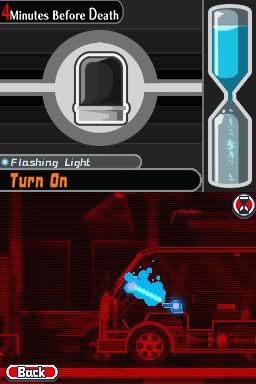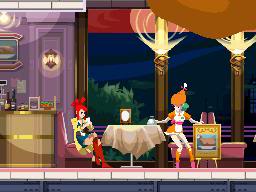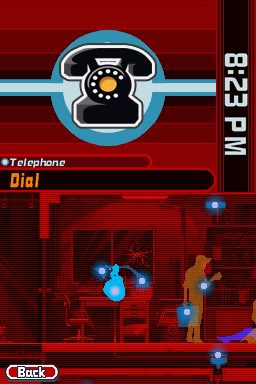This post has not been edited by the GamesBeat staff. Opinions by GamesBeat community writers do not necessarily reflect those of the staff.

When it was first announced, I was quite disappointed at Ghost Trick: Phantom Detective. The conservative side of my gamer psyche was more than happy for Capcom to stick to a good thing and churn out Ace Attorney 5. When they revealed a new and untested concept with a whole new cast, world and ideas, I wanted to hide. I didn’t want to take the risk and invest my limited susceptibility to hype into something that may not work. Ace Attorney 5 was a safe bet, one I felt Capcom were foolish to neglect.
I should’ve had more faith in Shu Takumi and his team.
My uneasiness with the new gameplay concept was echoed by Ghost Trick’s protagonist, Sissel, who wakes up to find himself dead. At first he doesn’t know his name, has no memories and needs a talking desk lamp called Ray to teach him the ropes.

The rules are simple: you are a ghost who can jump from one object to others nearby, activating “tricks” on some them to perform actions, such as turning on a light or making the fan spin faster. Travelling from area to area is done via the telephone lines; you use your phone book to dial numbers to travel to, and acquire these numbers via eavesdropping and tracing the location of the call. This method of travel keeps things simple within the fiction, and allows Sissel to easily find new and relevant locations to travel to when characters use the phone.
However, the game’s tutorial segments did little to assure players of the ease of travelling before letting us go on our merry way, so we're lucky that what had started as a rather awkward way of navigating quickly became second nature. Before I knew it, I was flipping cupboard doors open, swivelling desk lamps and rolling tires to traverse the environments. It’s actually more elegant and snappier than traditionally moving around would’ve been.
The bulk of the game revolves around the disembodied Sissel using these powers to manipulate the environment so he can prevent the deaths of the game’s colourful cast of characters, most of whom are detectives. From the red headed detective, Lynne (who has a habit of dying), through Ray, the old detective on death row, and to the adorably naïve pomeranian, Missle (named after the police dog from Ace Attorney), Ghost Trick’s unfamiliar gameplay is contrasted with a cast whose personalities resemble the eccentricities and absurdities of Ace Attorney’s most memorable characters.

These characters worked well inside Ghost Trick’s mystery plot. Starting off with questions ranging from what your name is to how to manipulate the environment, Sissel goes on a journey of discovery full of surprises and uncomfortable answers. By the end, every character gets closure, all the mysteries are solved, and the whole thing feels like it was neatly tied up with a bow on top. As a self-contained product, Ghost Trick’s narrative works as well as it should.
What Ghost Trick shared with Ace Attorney was comforting. It eased my initial fears about the game’s rather unique art style; instead of looking sharp and intimidating, the Ace Attorney-style personalities made it feel warm and endearing. The bright and colourful characters complimented their personalities and brought the whole thing to life.
In fact, I could tell straight away that this game was designed specifically for the DS. The bold colours with a lack of finer detail and the highly exaggerated animation suit the handheld’s limited hardware perfectly. Ghost Trick is possibly the best looking game the DS will ever see.

Another source of familiarity was the game’s soundtrack. From the tense music accompanying a murder scene to certain characters having catchy theme songs, Ghost Trick’s score perfectly captured the night time atmosphere whilst at the same time sounding like it could’ve been lifted from any of the Ace Attorney games, something I’m sure series composer Masakazu Sugimori made sure of.
With much of the game being similar to the Ace Attorney series, the biggest differentiator (and concern) was the puzzles, and it’s fair to say that they got it mostly right. The mix between puzzles that require you to work with precise timing, and those that simply require you to think your way through were neatly balanced. Occassionally there was the odd task that required a bit of trial and error — after all, Sissel can rewind time to precisely four minutes before the victim’s death as many times as he needs — but the solutions were relatively straightforward once you’d failed for the first time, so it rarely got frustrating.
One noteworthy problem was the attempt at explaining gameplay mechanics in the narrative. Unfortunately, I felt that in many cases it was completely necessary, as the alternative of not having them explained would be worse. However, that never stopped the convenience of being able to travel back four minutes from feeling plotted, even if the gameplay concept behind it was solid. Similarly, having the phone lines inexplicably blocked when you travel back in time was a poor narrative excuse to keep the action centered on one area; it would’ve made more sense if Sissel refused to go on account of the urgency of the scenario. These moments, as limited in number as they were, momentarily took me out of the experience.

All this said, whatever parts of the narrative felt poorly implemented were far outweighed by what worked, such as the characters, the plot’s neatness and the carefully planned mystery surrounding it. And unlike in some adventure games where information is withheld and then dumped on you in layers, Ghost Trick compounds these layers of information with hints and clues for the next part; enough for any player to notice them on replays.
Just like with other mystery adventure games, Ghost Trick can only work its magic once. After you know all the secrets and everything surrounding the mystery, there’s not much else the game offers beyond a yearning for that feeling again — the indescribable desire to prevent just one more death, only so you can see what happens next, or the genuine sadness you feel when Missile isn’t around, and how the mood completely changes when he unexpectedly returns — and unlike with Sissel, players don’t get to rewind time and experience that feeling again.
But I don’t think that’s to its detriment. Yes, Ghost Trick is one of those games you can only play once, but I’ll treasure that magical first experience for many years to come. It is, after all, one of the finest games I’ve ever played. I only needed one play through to tell you that.
Chris doesn't like writing reviews too much, but this is about as much as he can manage right now; he's not been in the best of health this month. Normal blogs will resume in February. In the meantime, get in touch with him on Twitter.
